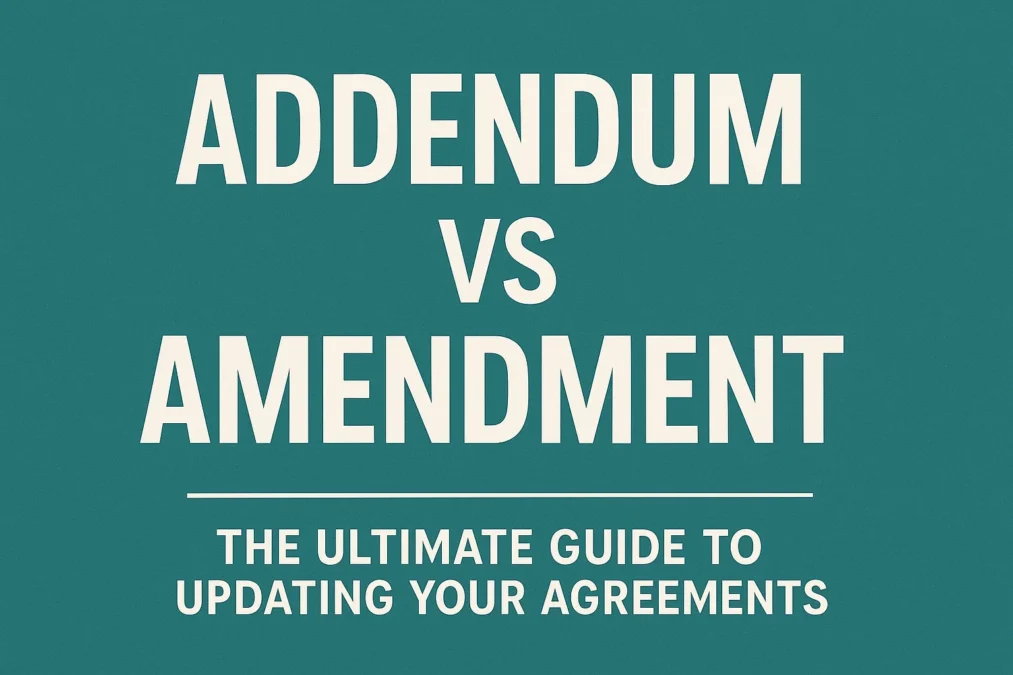In the world of contracts, documents, and legally binding agreements, change is the only constant. A deal evolves, new requirements emerge, or a simple oversight needs correction. When this happens, you can’t just grab a pen and scribble in the margins. The integrity of the original document and the intentions of all parties must be preserved through a formal, clear, and legally sound process. This is where two powerful tools come into play: the addendum and the amendment. While these terms are often used interchangeably in casual conversation, doing so in a legal or professional context is a significant error. Understanding the crucial distinction between an addendum vs amendment is not just a matter of semantics; it’s a fundamental skill for anyone dealing with contracts, from real estate agents and business owners to freelancers and renters. Misusing them can lead to confusion, disputes, and even render your modifications invalid. This comprehensive guide will demystify these terms, providing you with the knowledge to confidently and correctly modify any agreement.
What is an Amendment? Changing the Existing Terms
Let’s start by diving into the concept of an amendment. An amendment is a formal change, modification, or revision to an existing, already-signed agreement or contract. Its primary purpose is to alter the terms that are already contained within the original document. Think of it as editing the core content of the agreement. Amendments are used when the parties involved have agreed to change something that was originally decided. The key here is that the original contract remains in effect, but with specific clauses or sections now being different.
Common uses for amendments are everywhere. In a employment contract, an amendment might be used to change an employee’s job title or salary after a promotion. In a software development agreement, an amendment could adjust the project deadline. In a sales contract, it might change the delivery date of goods. The amendment directly targets and rewrites a part of the original deal. It’s crucial to note that for an amendment to be valid and enforceable, it typically requires the same formalities as the original contract. This means it must be in writing, signed, and agreed to by all parties who signed the original document.
The Legal Weight of an Amendment
The legal effect of an amendment is direct and powerful. Once properly executed, the amended条款 (terms) replace the original terms entirely. The old language is effectively erased and the new language takes its place. This is why precision in drafting an amendment is absolutely critical. A poorly worded amendment can create more ambiguity than it resolves. For example, an amendment that states, “The delivery date in Section 4(c) is changed to October 15th,” is clear and replaces only that single date. However, a vague amendment like, “The delivery terms are updated,” could lead to arguments over what exactly was changed.
Because amendments alter the core agreement, they can sometimes be subject to intense scrutiny, especially in high-stakes deals. All parties must have a “meeting of the minds” regarding the change, meaning there is a clear and mutual understanding of what the amendment does. It’s not uncommon for amendments to themselves be amended, creating a chain of modifications that must all be read together with the original contract to understand the current, full agreement between the parties.
What is an Addendum? Adding Entirely New Terms
Now, let’s turn our attention to the addendum. An addendum is a separate document that is attached to the end of an original, completed contract. Its purpose is not to change existing terms but to add new information, terms, or provisions that were not included in the original agreement. If an amendment is an editor, an addendum is an appender. It expands the scope of the contract without disturbing the existing text. The original contract remains completely untouched and in full force; the addendum simply adds more to it.
You would use an addendum when new elements come to light after the contract is signed but before it is fully executed, or when additional details are necessary that weren’t contemplated initially. A classic example is in a residential lease. The original lease agreement might be signed, and then the landlord and tenant agree that the tenant can have a pet. Rather than rewriting the lease, they would use a pet addendum. This new document outlines all the new rules: pet fees, cleaning responsibilities, and any restrictions. It becomes a part of the overall lease agreement.
The Expansive Nature of an Addendum
The beauty of an addendum lies in its ability to keep the original contract clean and intact while still accommodating new and agreed-upon elements. It’s a tool for addition, not correction. Other common examples include adding a list of included furniture to a home purchase agreement, attaching technical specifications to a manufacturing contract, or including a new schedule of milestones to a project plan. The addendum should clearly reference the original contract by name, date, and parties, and it must be signed and dated by all parties to be enforceable.
It’s important to understand that the terms within an addendum can sometimes contradict the original contract. To avoid this, a well-drafted addendum will always include a clause that states something like, “In the event of a conflict between the terms of this Addendum and the original Agreement, the terms of this Addendum shall prevail.” This establishes the hierarchy of the documents and ensures the new intentions are respected. Without such a clause, a court might have to decide which term governs, leading to unnecessary legal uncertainty.
Key Differences Between an Addendum and an Amendment
While both an addendum and an amendment are used to modify a contract post-signing, they do so in fundamentally different ways. The core difference lies in their function: an amendment changes existing terms, while an addendum adds new ones. This simple distinction dictates when you should use each tool. If the original deal is good, but you need to add something completely new (like a pet policy), you need an addendum. If the original deal has a term that needs to be altered (like a price or a date), you need an amendment.
Another key difference is their relationship to the original document. An amendment is integrated into the original contract; it becomes a part of its fabric by replacing specific sections. An addendum, on the other hand, remains a separate document that is physically attached to the original contract. It is a distinct entity that supplements the agreement. You might have one original contract with three addendums attached to it, each covering a different additional topic.
Impact and Execution
The impact on the original contract also varies significantly. An amendment actively revises and overwrites parts of the original agreement, making the old terms null and void. An addendum leaves the original agreement perfectly intact and simply adds more content to the overall package. From a procedural standpoint, both require the mutual agreement and signatures of all original parties to be legally binding. However, the process of negotiating an amendment can sometimes be more complex, as it involves re-opening agreed-upon terms, which can be a sensitive matter. Negotiating an addendum is often about something new, which can feel like a separate, additive negotiation.
When to Use an Addendum vs Amendment in Real-World Scenarios
The theoretical difference is clear, but how does it play out in practice? Let’s look at some concrete scenarios to solidify your understanding. Imagine you are a freelance graphic designer. You sign a contract with a client to design a logo for $1,000, with a delivery date of June 1st. Two weeks later, the client loves your work and asks you to also design business cards and letterhead. This is a new, additional service. You would use an addendum to the original contract. This addendum would specify the new deliverables (business cards, letterhead), the additional fee, and the new timeline for these items, all without changing the original terms for the logo design.
Now, imagine a different scenario with the same initial contract. You’ve signed to deliver the logo by June 1st, but a key team member falls ill, making that deadline impossible. You and the client agree to push the delivery date to June 15th. This is a change to an existing term (the deadline). You would use an amendment. This amendment would specifically state, “Section 3, Delivery Date, is hereby amended from ‘June 1st’ to ‘June 15th’.” The original contract is thus changed only in that one specific aspect.
Real Estate and Lease Examples
The real estate industry is a prime example of both tools in action. A purchase agreement might be signed, and then the buyer’s home inspection reveals a broken furnace. The buyer requests a credit for $5,000 at closing to cover the replacement cost. The seller agrees. This change to the financial terms of the original contract is handled through an amendment. It modifies the purchase price and closing details. Conversely, if the seller agrees to leave behind their washing machine and dryer, which were not mentioned in the original listing, this new item would be added via an addendum to the purchase contract, listing the appliances being included.
In leasing, the standard lease is often accompanied by multiple addendums. There might be a lead-based paint addendum (a federal requirement), a mold addendum, or a parking space addendum. These don’t change the rent or lease term but add new rules and acknowledgments. If, however, after a year, the landlord and tenant agree to a rent increase, that fundamental change to the core economic term of the lease would be done through a lease amendment.
The Legal Implications and Enforceability
Whether you choose an addendum or an amendment, the legal stakes are high. An improperly executed document can be challenged in court and potentially deemed unenforceable. The foundation of enforceability is mutual consent. All parties who are bound by the original contract must also agree to and sign the addendum or amendment. You cannot unilaterally change a contract. This mutual agreement must be clear and unambiguous, reflecting a true meeting of the minds on the new or changed terms.
Consideration is another critical legal concept. In contract law, consideration is something of value exchanged for a promise. For a new amendment or addendum to be binding, there must usually be consideration on both sides. For example, in an amendment to extend a project deadline, the consideration for the client is getting a more complete product, and the consideration for the designer is avoiding a breach of contract and potentially receiving a later payment. If one party agrees to a change without receiving anything in return (a concept known as a “gratuitous promise”), a court might find the amendment lacks consideration and is therefore unenforceable.
Avoiding Ambiguity and Future Disputes
The single best way to ensure your addendum or amendment is legally sound is to be incredibly specific. Vague language is the enemy of a good modification. Reference the original contract by its exact title and date. Use precise language like “Section 4(b) is hereby deleted in its entirety and replaced with the following…” for an amendment, or “The following is added as Addendum A to the Agreement…” for an addendum. Clearly state that the document is intended to be an integral part of the original agreement. It is often wise to have such documents reviewed by a legal professional, especially for high-value or complex contracts, to ensure your interests are fully protected and the modification will hold up if challenged.
Best Practices for Drafting and Executing These Documents
Creating a legally robust addendum or amendment doesn’t have to be daunting if you follow a set of best practices. First, always use a clear and descriptive title at the top of the document. “First Amendment to the Service Agreement dated [Date]” or “Addendum A regarding Pet Policy” leaves no room for doubt about the document’s purpose. The first paragraph should explicitly reference the original agreement, stating its title, date, and the parties involved. This creates an undeniable link between the two documents.
Within the body of the document, use unambiguous language. For amendments, explicitly state which section, clause, or paragraph is being modified and provide the new language in full. It is not enough to say “the price is changed”; you must state “The ‘Fees’ section, subsection 2.1, is amended to read ‘The total fee shall be Five Thousand Dollars ($5,000.00 USD)’.” For addendums, clearly outline the new terms, responsibilities, and obligations being added. Finally, include an execution block at the end with signature and date lines for all parties. The act of signing is what formalizes the agreement to the changes or additions.
VRBO vs Airbnb: Which Vacation Rental Platform is Right for You?
Keeping a Clear Paper Trail
Once the addendum or amendment is fully executed (signed by all parties), it is imperative to attach it physically or digitally to the original contract. All parties should retain a complete copy of the original agreement with all subsequent modifications attached. This complete package represents the entire and current agreement between the parties. Maintaining this clear paper trail is essential for avoiding future disagreements about what was agreed upon and when. In any dispute, the court will look to the “four corners” of the contract documents, meaning the original contract and all its properly executed addendums and amendments, to determine the intent of the parties.
Common Mistakes to Avoid
Even with the best intentions, people often make mistakes when dealing with addendums and amendments. The most common error, as we’ve discussed, is using the terms interchangeably. This confusion can lead to using the wrong document for the situation, which can create legal ambiguity. For instance, trying to use an addendum to change a price could result in a situation where both the old price and the new price appear to be in effect, as the addendum adds the new price without nullifying the old one.
Another frequent mistake is making oral agreements. A verbal “okay” to a change is almost never legally enforceable for contracts governed by the Statute of Frauds (which includes contracts for the sale of goods over a certain value, real estate, and contracts that cannot be performed within one year). Always get it in writing. Furthermore, failing to get signatures from all necessary parties is a critical error. If one party signs and the other doesn’t, the modification is not binding. Finally, ensure the addendum or amendment does not accidentally invalidate other important parts of the contract. A careless change can have unintended consequences that ripple through the entire agreement.
Comparison Table: Addendum vs Amendment
| Feature | Addendum | Amendment |
|---|---|---|
| Primary Purpose | To add new information or terms not in the original contract. | To change, modify, or delete existing terms in the original contract. |
| Effect on Original | The original contract remains completely unchanged and in full effect. | The original contract is directly altered; old terms are replaced by new ones. |
| Nature | Supplemental and additive. | Revisionary and corrective. |
| Content | Introduces entirely new clauses, items, or provisions. | Targets and rewrites specific, existing clauses or sections. |
| Document Status | A separate document that is attached to the original contract. | A document that is integrated into the original contract, effectively becoming part of it. |
| Common Use Case | Adding a pet policy to a lease, including a list of furniture in a sale. | Changing a price, altering a deadline, modifying a scope of work. |
Quotes from Legal Experts
“The distinction between an amendment and an addendum, though subtle on the surface, is a cornerstone of clear contract management. Using the wrong tool can introduce ambiguity, and in law, ambiguity is often resolved against the party who drafted the document. Precision here is not just advisable; it is protective.” – Jane Doe, Esq., Contract Law Specialist
“In my practice, I see countless disputes that arise from poorly drafted modifications. A well-drafted amendment is a surgical instrument, making a precise change. A well-drafted addendum is a new chapter, adding to the story without editing the previous pages. Understanding which one you need is the first step to avoiding litigation.” – John Smith, Commercial Litigation Attorney
Conclusion
Navigating the intricacies of contracts requires a clear understanding of the tools at your disposal. The choice between an addendum vs an amendment is a fundamental one, with each serving a distinct and vital purpose. An amendment revises the existing script of your agreement, while an addendum adds new scenes to the play. By grasping this difference—that amendments change existing terms and addendums add new ones—you empower yourself to manage your professional and personal agreements with confidence and precision. Always remember to be specific, get everything in writing, secure all necessary signatures, and when in doubt, seek legal counsel. Mastering this aspect of contract management will ensure your agreements remain clear, current, and legally enforceable, protecting your interests and fostering stronger, more trustworthy relationships with all parties involved.
Frequently Asked Questions (FAQ)
What is the main legal difference between an addendum and an amendment?
The main legal difference lies in their effect on the original contract. An amendment has the legal power to alter the actual terms of the original agreement. It replaces, deletes, or modifies existing language. An addendum, however, does not change the original contract at all. Instead, it has the legal effect of adding new terms and provisions that become a part of the overall agreement alongside the original, untouched text.
Can an addendum override the original contract?
Yes, but only if it is explicitly written to do so. A well-drafted addendum will often include a clause that states something like “in the event of a conflict between the terms of this Addendum and the original Agreement, the terms of this Addendum shall control.” Without such a clause, if a term in the addendum directly conflicts with a term in the original contract, it can lead to legal ambiguity and a dispute over which term was intended to be effective.
Do both an addendum and an amendment require signatures?
Absolutely. For either an addendum or an amendment to be legally binding and enforceable, it must be signed by all parties who signed the original contract. This signifies mutual agreement to the new additions or changes. An unsigned modification is generally not enforceable and is considered merely a proposal or a draft.
Is it possible to have multiple addendums and amendments to one contract?
Yes, it is very common for a single contract to have multiple amendments and addendums over its lifetime. For instance, a long-term software license agreement might have several amendments to update pricing and several addendums to cover new modules or services added to the package. It is crucial to keep them all organized, numbered (e.g., Amendment 1, Amendment 2, Addendum A, Addendum B), and physically attached to the original contract.
Which one should I use to change a date or a price in a contract?
You should always use an amendment to change a date, price, or any other term that already exists within the original contract. Since you are modifying an existing provision, the amendment is the correct tool to formally make that change and ensure the old date or price is no longer valid. Using an addendum for this purpose would be incorrect, as it would simply add a new date or price without nullifying the original one, creating confusion.



